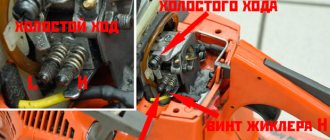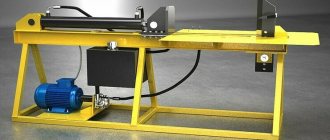June 22, 2020
Chainsaws are a very popular gardening tool. They have gained great popularity among gardeners and those who care for the territory in their home areas. Construction or repairs cannot be done without chainsaws. Chainsaws are even more important in the lumberjack profession.
Any chainsaw requires proper care, maintenance and adjustment before use. If you put too much stress on the tool, it may shorten its life and cause the tool to break.
Today we will talk about that part of the chainsaw mechanism, the task of which is to prepare the fuel before it is supplied to the engine cylinder. This function is performed by the chainsaw carburetor. How well the chainsaw works and how much fuel it consumes during operation will depend on it. If you see that your gasoline chain saw is starting to run erratically, the carburetor may need to be adjusted.
The design and principle of operation of the carburetor
The main purpose of a carburetor in any internal combustion engine is to mix fuel with air in certain proportions. If they are violated, the engine starts to work incorrectly or stops completely.
Chainsaw carburetors of different brands have some differences in design, but the main components of this part, as well as the principle of their operation, are approximately the same:
- The base (body) is a wind tube with an air damper located across it. Its purpose is to regulate the air supply to the inner chamber.
- The float chamber is a container that holds the fuel mixture in a stable state.
- The atomizer is the area where air and fuel come into contact. Fuel enters the atomizer from the float chamber through a nozzle.
- A diffuser is a part that increases the speed of air flow, with the help of which the required pressure is maintained. The diffuser is located in the narrowed part of the tube.
The operating principle of the carburetor is as follows:
- After the engine starts, the damper opens and air enters the channel.
- The flow rate and the level of the float in the chamber are regulated by the position of the damper, due to the difference in pressure in the float chamber and the air channel.
- Fuel from the float chamber is sucked into the nozzle and then into the diffuser. Moving through it, the air captures the incoming fuel.
- The resulting mixture is fed into the cylinder cavities through the intake channels.
Mechanic at home: adjusting the carburetor of a chainsaw with your own hands
Any internal combustion engine requires periodic maintenance, no matter whether it is the engine of a simple moped or a powerful multi-ton tractor. A tool such as a chainsaw was no exception. After all, it is equipped with a single-cylinder two-stroke internal combustion engine, which also requires serious maintenance, although it is much easier to perform the necessary actions here. In today’s article we’ll talk about how to adjust a chainsaw carburetor with your own hands, find out how difficult it is, and figure out whether you need to be a professional mechanic to do this kind of work.
How does a chainsaw carburetor work, on what principle does it work?
Modern car engines are no longer equipped with a carburetor. Meanwhile, previously, almost every driver knew how to adjust it. Today, chainsaws with injection engines have already begun to appear on sale, but carburetor models will hold the palm for a long time, because their cost is 5-15 times lower than that of the modern version.
The carburetor consists of several main parts:
- aluminum body;
- diffuser and air damper at the inlet;
- jets (valves for regulating fuel supply);
- sprayer (it is the one that provides injection);
- fuel (float) chamber.
Initial adjustment and starting to use the saw
Most instruments come pre-configured by manufacturers.
During the running-in process, the correct operation is checked:
- When starting up for the first time, you need to ensure that the chainsaw operates in a gentle mode. A few hours after the start, it is recommended to cut small branches and trunks up to 10 cm thick.
- The chainsaw must start correctly, ensure a stable rotation speed of the sprocket and a smooth increase and decrease in power.
- Fuel consumption must correspond to the power used and in practice the saw should not go out, “sneeze”, smoke or run jerkily.
- There should be no extraneous knocks, pops or noises when the engine is running.
The following rules will help you stay safe:
- Mix gasoline and oil in accordance with the proportions specified by the manufacturers.
- Do not prepare the mixture in advance. The properties of gasoline and oil in a mixed state change over time. The exception is fuel for intensively used tools, however, even here the norm of 7 days should not be exceeded.
- Use oil designed for the chainsaw brand engine. A fuel mixture with a non-standard composition will damage it.
- When preparing the fuel mixture, take into account the influence of climatic conditions on the components.
Output
It is not difficult to adjust the carburetor on a chainsaw independently and without relevant experience. All you need to do is follow the algorithm above .
It is important to install dust for some time worked in working conditions . If there are deviations, correct them according to the same instructions. After troubleshooting, the setup procedure can be considered complete.
If you use a TM Foresta tool, the company's service center staff will ensure a free and professional adjustment of your chainsaw's carburetor without the risk of damaging the tool.
Source
Chainsaw. a useful and sometimes simply necessary tool for the owner of a private home. It has a high degree of independence and can be used in field conditions where there is no possibility of connecting to the mains. For some craftsmen, a chainsaw is one of the main devices that performs large volumes of work almost every day. Such loads throw off the factory settings for all important engine components.
The operating mode is often changed by the carburetor, which must be reconfigured. Without an idea of the design and operating principle of this element, it is impossible to adjust it correctly. This issue concerns many users who work closely with chainsaws, so it will be useful to consider this more carefully.
Signs of incorrect carburetor operation
Carburetor malfunction may be due to clogged intake ports and incorrect settings.
Signs of incorrect operation:
- Gasoline consumption is increased, thick white smoke comes out of the exhaust port;
- the engine runs with difficulty, with a characteristic sound;
- the engine starts and stalls or does not start at all;
- the chainsaw “shoots” at the carburetor.
Is adjustment always necessary?
Before interfering with the factory settings of the carburetor, make sure that the incorrect operation of the chainsaw is associated with it:
First, make sure that there is a fuel mixture in the tank of the saw that does not want to start and that it is entering the carburetor.
If the tank is full, check the fuel line. Disconnect the tube from the carburetor and perform pumping. If everything is in order, gasoline will spit out in accordance with the manufacturer's standards.
Weak flow indicates a clogged channel or fuel filter. In this case, it is enough to clean the fuel pipe and replace the filter.
Incorrect operation of the tool may be due to an overfilled chainsaw tank. In this case, smudges will be visible under the crater cover. If they are, check the connection of the fuel pipe to the carburetor. It is sometimes squeezed out when screwing on the cap of an overfilled tank. The engine may not start for this reason.
The reason for poor chainsaw performance may be the quality of the oil-gasoline mixture. If you do not drain the residue and leave the instrument in storage for more than 2 weeks, the processes of resin formation and polymerization of the components will begin to occur in the tank. This can cause carbon deposits to form on the piston, rings and cylinder liner. Therefore, always prepare the mixture immediately before work in the required quantity.
If the fuel quality is fine, the chainsaw engine may not start due to clogged fuel and air filters:
To diagnose the fuel filter, disconnect the gasoline supply channel from the carburetor and pump fuel. If there is little or no pressure in the pipe, disconnect the filter.
Before doing this, empty the tank of the mixture and remove the filter element itself. A clogged replacement cartridge can be cleaned, but it is best to replace it with a new one. When using the tool in dusty conditions, cleaning should be done regularly.
Remove the air filter carefully so that dust accumulated on its surface during operation does not get into the carburetor: this may require expensive repairs.
After disconnecting the cartridge, thoroughly clean it of accumulated dirt and wash it with detergent. Then dry it and carefully put it back in place.
Popular faults
The only negative review about the malfunction of the PIT chainsaw that has become known is the leakage of the oil tank plug.
The exact reasons are unknown, they may be:
- Defects in the thread of a hole or plug when molding plastic.
- Defects in the rubber gasket.
- Thread stripping by the user due to over-tightening.
If there is an obvious manufacturing defect, the product must be replaced. In case of your own negligence, the problem can be solved:
- Changing the gasket.
- By applying an oil-resistant sealant to the threads, this will increase their relief and can restore tightness.
Customization technology
The main tool used to tighten screws is a screwdriver that fits their slots. On different carburetors they are flat, cruciform, with an internal or external hexagon, or an asterisk.
Expert opinion
Torsunov Pavel Maksimovich
Some tool manufacturers Husqvarna, Homelite, MTD equip their carburetors with jets for a special screwdriver. This was done to make it as difficult as possible for the owner to independently adjust the carburetor.
It can be assumed that the purpose of this is to “make money” on the sale of screwdrivers for adjustment: they are really expensive. But in fact, this is done to protect the saw engine from incorrectly set maximum speeds.
Control the setting with a tachometer. If it is not there, you will have to rely on your own hearing, and this is not always effective.
Step-by-step instruction
The main steps for setting up a carburetor:
- adjustment at low speeds;
- setting the correct fuel supply at maximum speed;
- fine tuning at idle speed;
- checking the operation of the tool in all modes.
3 screws are used for adjustment:
- T – is responsible for fine tuning at idle;
- H – setting of operation at maximum speed;
- L – adjustment of the formation of the fuel mixture at low speeds.
Setup process
The adjustment consists of the following steps:
- Set screws L and H to standard setting. This is 1/5 turn of the screws until they are fully tightened.
- Start the engine and warm it up a little.
- Adjust the low speed mode with screws L and idle speed T. First, tighten screw L until maximum engine speed is obtained. Then release it 1/4, and use screw T to return the idle speed to normal.
- After adjusting the operation at the “bottoms”, adjust the traction and maximum speed. To do this, slowly tighten screw H and check the speed using the electronic tachometer. Do not exceed the maximum speed limits recommended class=”aligncenter” width=”749″ height=”206″[/img]
- Adjustment of screw L is stopped when the engine runs smoothly, moves smoothly from low to high speeds and does not smoke.
- The final stage is to check the operation of the saw in all modes. First let the tool cool, then do a test run at idle speed.
- If the tool operates normally, test it under load.
- If there is insufficient power, repeat the adjustment of screw H by unscrewing it and checking the traction again. Loss of traction at maximum speed is an indicator of CPG wear or poor fuel quality.
Some nuances
During the process of setting up the carburetor, some non-standard and dangerous situations for the performance of the tool may arise:
- Tightening the screw L too much relative to H can lead to the formation of a lean fuel-air mixture. When there is a lot of air and little gasoline in the carburetor, the piston group dries out and may fail.
- Factory Chinese carburetors are configured on benches taking into account the characteristics of each chainsaw. Any change in the position of the screws during adjustment must be remembered or recorded. This will help you return to factory settings if the engine does not start.
- New carburetors for Chinese saws are regulated at the factories by a standard number of revolutions or arbitrarily. They may require adjustment immediately after installation on a particular instrument.
Reference! Currently, there are many models of chainsaws made in China, less often in Europe, on the market, which simply do not have adjusting screws. Their adjustment only involves adjusting the idle speed with one screw, when the tool stalls or produces rare revolutions).
How to understand that the setting is correct
The following signs indicate effective and correct configuration:
- The chain does not move at idle;
- The motor runs smoothly;
- There are no interruptions in operation when starting and pressing the gas.
Adjustment tools
To adjust the carburetor, you will need Phillips or slotted screwdrivers of varying lengths or thicknesses. The size depends on the design of this unit and the characteristics of the engine assembly. It should be noted that some manufacturers produce carburetors designed for use with special tools.
In particular, installation of Husqvarna carburetors and other imported tools may require a special screwdriver. It is advisable to clarify this issue even when purchasing a chainsaw, so that you can purchase the necessary additional equipment in advance.
In addition, washed gasoline or acetone will be needed to flush and clean the device. They are used to clean the external surfaces of the carburetor. All internal channels are washed with kerosene, diesel fuel or white alcohol. Before washing the carburetor, remove all rubber or plastic parts that may come into contact with aggressive chemicals.
Wrenches or ring wrenches are used to disassemble the carburetor. Washing of internal channels is carried out in specially designated baths; sometimes plastic syringes are used for this.
User questions about chainsaws
The Husqvarna chainsaw started only on choke and then stalled. I bought a new Chinese carburetor, it looked exactly the same, it started idling smoothly and started without any suction. You start sawing and after 2 seconds it stalls. If you re-gear it, it still cuts for a little while, but then it still doesn’t hold high speeds. What's the matter?
First, check the fuel filter. If OK, back out the low speed screw (L) until it starts to pick up speed normally. Since X.X will increase, reduce it with the bolt (T) that is on top.
Chainsaw McCULLOCH MAC930 CC30 KW1.2 tire 35 cm, assembled in Italy in the 90s. Piston, seals are ideal. Doesn't hold idle speed or doesn't pick up speed when you try to accelerate it, it feels like it's choking on gasoline. Gasoline is pouring from the exhaust. What is the problem and how to fix it?
According to the symptoms described, gasoline is not flowing well, probably because the diaphragm has dried out due to long inactivity. You can fill the saw with gasoline, pump it manually and leave it for a while. From gasoline, all the rubber bands should get wet and start working. If that doesn’t help, then you can pick up a carburetor from some modern Chinese saw of similar cubic capacity (for example, from Shtil). After replacement, adjust the joint with the cylinder.
If I fill a Husqvarna chainsaw with Stihl oil or any other branded oil, should I follow the proportions of 1:25 as indicated in the instructions?
If branded oil for two-stroke engines is poured, then it does not matter which manufacturer it is from. High-quality fuels and lubricants from well-known brands are interchangeable, and recommendations are only a marketing ploy. You can safely fill a Stihl chainsaw with Husqvarna oil and vice versa, observing the proportions as for branded fuels and lubricants.
Why does a chainsaw cut crookedly, that is, it moves to the side?
The tire misaligned due to uneven wear. Don't forget to turn it over when working! If the tire is already worn unevenly, only replacement will help.
Why does the Taiga 245 chainsaw only work on suction and the carburetor cannot be adjusted?
Possible options: the carburetor diaphragm is broken, the gasket between the cylinder and the crankcase, the carburetor and the cylinder is not sealed, the crankshaft seals are leaking. In Taiga 245, when air is sucked into the crankcase from the outside, the functionality of the fuel pump built into the carburetor is disrupted due to the lack of vacuum. In this case, the saw will not work. The suction closes the air supply to the carburetor. This confirms the lack of tightness in the places indicated above.
Equipment
In a sealed PIT box, the buyer receives, along with the saw, a set that is standard for most brands:
- tire;
- chain;
- universal screwdriver for spark plug and tire fastening;
- instruction manual with warranty card.
In addition, the PIT buyer receives:
- second spare chain;
- measuring tank for precise dosage of oil for mixing with gasoline.
Different PIT models differ significantly from each other in layout and appearance. Some of them are estimated to be similar to the best Carver chainsaws. Others look like Hitachi.
How to install a saw made in China?
The design of the carburetor on Chinese chainsaws is no different. The installation procedure and principle are also the same and are performed in the same order. The only difficulty that may arise during work. This is to determine the purpose of the adjusting screws. Typically the T screw is at the top and the H and L screw are located at the bottom of the carburetor body. There may be one extra screw there.
Figure 3. Location of control mechanisms
Usually their goal is determined experimentally, slightly changing the position and monitoring the result. Once the purpose of the elements is clearly defined, further configuration is straightforward and can be done in the usual way.
Adjusting the chainsaw carburetor is an important and necessary procedure that must be performed periodically to restore normal operation of the tool. This process does not create any fundamental difficulties, but requires the user to be careful, attentive and follow safety rules. Chainsaws are usually not removed because you need to keep an eye on their position. Therefore, it is important to always remember the possibility of triggering it and exercise the necessary caution.
The adjustment should be made smoothly, with slight changes in the position of the screws, so as not to cause too sudden changes in the mode of rotation of the shaft. The result depends on the care and diligence of the user, and a properly adjusted carburetor will extend the life of the tool.
Source
Is disassembly necessary?
You can adjust the carburetor of a chainsaw without any disassembly at all; in rare exceptions, you only have to remove the air filter cover. There is a considerable amount of contradiction here: on the one hand, the chainsaw is designed for unhindered access to the adjustment mechanism, on the other hand, it is recommended to access it as little as possible.
True, experienced fellers and sawers always carry a flat-head screwdriver with a long blade and periodically adjust the carburetor. This is explained simply: during the manufacture of a chainsaw, its carburetor undergoes rough adjustments designed for a certain composition of air and fuel. It is clear that the conditions at the work site are different from those on the bench.
When changing the brand of gasoline or, for example, increasing air humidity, an experienced chainsaw user will always adjust the quality of the mixture for greater performance and less wear on the piston part. But this, we repeat, requires considerable experience in working with a specific chainsaw and knowledge of the peculiarities of its behavior. In addition, the adjustment is incredibly fine - the screws are tightened by only 1/10...1/20 of a turn.
Another reason for adjustment is carburetor repair or replacement. In any case, adjustment of the mixture quality should be carried out only if the serviceability of the carburetor is reliably known (no debris, gaskets are not poisoned), the air filter is clean, the spark plug, clutch and ignition system are in perfect order. Otherwise, there is a high probability that the malfunction will be eliminated in a moment and the adjustment will suddenly become incorrect, and the engine will begin to wear out.











